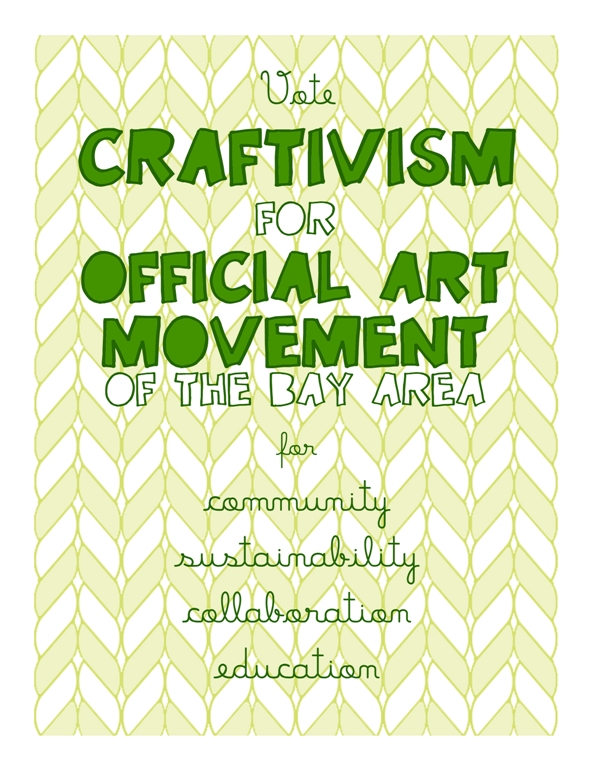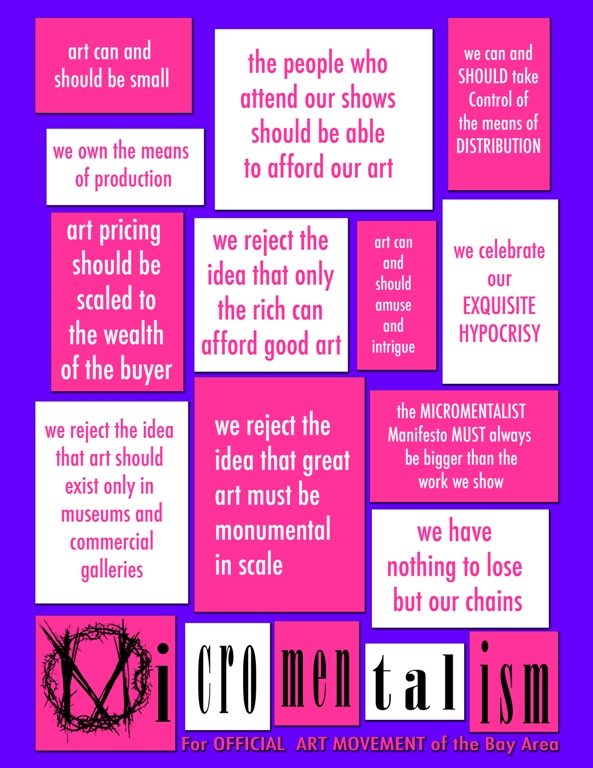Vote Art for Change
Featured Community Voice: Art for a Democratic Society
Citizens in Oakland, California are casting their ballots in a unique election. Art Election is a participatory public art project by Oakland-based Art for a Democratic Society in which participants elect the "Official Art Movement of the Bay Area." In the running are six candidates: Church of the Holy Mist, Craftivism, Micromentalism, Postmodernism, Remodernism, and Tomorrowism. The following is a partial transcript of a debate between the incumbent, Postmodernism, and the two front-runners, Craftivism and Micromentalism, moderated by Art for a Democratic Society. Each candidate delivers its platform on women in the arts--making a case for why it should get the women's vote.

This debate will focus on issues pertinent to women in the arts and I would like to start by asking each of the candidates what they will do for women if elected to the office of Official Art Movement of the Bay Area. We will begin with the candidate that is currently leading in the polls, Craftivism.
Craftivism: Firstly, Craftivism is a movement founded by women. Women are leaders and originators of various groups within the movement, so we feel that it's difficult to talk about Craftivism without talking about women. I think that's a big part of our popularity in this election--many people feel Postmodernism wasn't addressing issues that women care about, such as inclusion in galleries and in positions of power at galleries and institutions, representation in critical dialogue, and elevating the status of art traditionally labeled and denigrated as "women's work." All of these issues are central and integral to Craftivism as a movement.
Moderator: Postmodernism, why should female voters choose to elect you to another term in office?
Postmodernism: Although I reject the idea of an "official art movement" I think if voters consider the state of women in the arts before and after Postmodernism, you will see that I have helped to bring many women into the arts. I have achieved this though bringing a critical perspective to the way we think about art and art history. I have opened the door to skepticism about the traditional representations of gender in art. I have helped to pave the way for movements such as Craftivism because I helped break down the barriers between high or low art and redefine what mediums are considered worthy.
Moderator: Micromentalism, same question.
Micromentalism: Like my fellow candidates, I wish to see greater access to the arts for all people, women in particular. The other candidates have some interesting ideas and theories about the relationship of women to art; however I believe we must begin to seriously think through how to address concretely the problems of under-representation in the art world. Theory is important, but without concrete action, even the best theories are meaningless. Of the candidates represented at this debate, only Micromentalism has a plan to actively create democracy and equality in art. Our platform is straightforward and immediate. First, Micromentalists call for smaller works of art -- this means more space for more art in our shows which consequentially means that group shows can involve more artists. Secondly, the increase in university tuitions and the gutting of art programs in public schools means that fewer people today are given the space and time to develop their skills. By working small, artists reduce their costs in time and materials per each work and can afford to experiment and therefore develop artistically.
Moderator: Craftivism, how do you respond to the charges that you aren't concretely addressing these problems?
Craftivism: By creating an alternative economy in which consumers choose to buy locally handmade products, Craftivism improves working conditions of women who work in sweatshops. If everyone chose what they purchased with more consciousness of where and by whom it is made, we would see the demand for products made using exploitative mass-production techniques disappear, and companies using sweatshop labor would be forced to improve labor standards. We also train and empower women crafters to start their own businesses. While Micromentalism may have very concrete plans regarding the production and sale of art, they don't even mention women in their manifesto. They also focus primarily on painting as an art-making technique, failing to recognize all of the craft traditions as valid. In essence, Micromentalism has a reductionist single-issue platform that fails to address many aspects of the complex art world.
Moderator: Postmodernism, do you believe it's a fair criticism to say that you have no concrete proposals to offer women?
Postmodernism: Is there such a thing as an unfair criticism? I believe that introducing criticism of grand universal explanations of our diverse world is a valuable way of helping women and everyone else. For example, a Postmodern view of the world has helped many artists and writers expose patriarchy and male-centric narratives of art history. Is this a concrete way to help win equality? It's probably no more or no less than what Craftivism is doing. In fact, one could ask: Is Craftivism helping the conditions of women in sweatshops? If they are effective does that mean they are actually just taking jobs away from poor women who work in sweatshops? Or, are they really not having any impact on women in sweatshops at all?
Moderator: Since you criticized the other movements for not having concrete solutions, what would Micromentalism say to the charge that its manifesto fails to specifically address women in the arts?
Micromentalism: It's a fair charge, because our manifesto simply doesn't directly address these issues, but it doesn't mean we don't think they are important. The first step in building an art movement that can allow everyone's voice to be heard is simply to make room and encourage those voices to speak.
I think Postmodernism takes a little too much credit for the progress made in the art world. I believe the women's liberation movement did more for female artists than any art movement has. It built the structures that could allow women to go to universities and seek their own careers as artists. In the 70s and early 80s, there were many female and feminist artists and Postmodernism was only beginning to become the dominant force in art. Now that it is the orthodoxy, we would expect to see real equality in the art world, but really, we're in a stagnant era for diversity in the arts.
Moderator: That will have to conclude this debate, but I hope that it can serve as a jumping off point for future exchanges about the current state of the arts.



